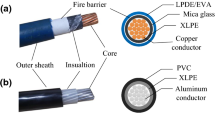Abstract
Understanding the fire characteristics of stayed-cable bridge, such as fire growth, during accidental fire is essential to develop prevention strategies for potential damage. This study focuses on the effects of high cable fire that may result from a short circuit or a lightning strike since high flammability heat release characteristics of HDPE sheath causes burning of nearby cables. Fire propagation behaviors on one single cable and between two adjacent cables under working conditions with different inclination angles were obtained. The temperature distribution, drop ignition behaviors and flame spread rate were analyzed. The results show that flame propagation characteristics of stay cables seriously changed as the angle of inclination increases, which explain the fracture sequence of cables to some extent for the Red Stone Bridge fire event. The particle size of molten substance formed by combustion of the upper-layer cables increases, and the ignition position for the under-layer cable gradually moves down as the increase of inclination angle. Moreover, increased inclination angle also resulted in increase in flame height and molten drops flow rate and reduce in the duration of the prosperity stage for cable fire. Although HDPE sheath is a protective device, it does prevent the combustion for inner strands from becoming intense, but once ignited, would become the main fire load, promoting fire development.














Similar content being viewed by others
References
Garlock M, Payá-Zaforteza I, Kodur V, Gu L. Fire hazard in bridges: review, assessment and repair strategies. Eng Struct. 2012;35:89–98.
Liu YJ, Bo N, Wang Y. Study on thermal and structural behavior of a cable-stayed bridge under potential tanker truck Fires. Appl Mech Mater. 2012;238:684–8.
Quiel SE, Yokoyama T, Bregman LS, et al (2015) Mitigating the effects of a tanker truck fire on a cable-stayed bridge. In: International conferrence on performance-based and life-cycle structure engineering, pp 1002–1012.
Chen CK, Chen J, Zhao XL, Shi CL. Experimental investigation on combustion characteristics of steel cable for cable-stayed bridge. J Therm Anal Calorim. 2018;134:2317–27.
Payá-Zaforteza I, Garlock M. A numerical investigation on the fire response of a steel girder bridge. J Constr Steel Res. 2012;75:93–103.
Perissayol G, Payá-Zaforteza I, Alosmoya J, Hospitaler A. Analysis of the influence of geometric, modeling and environmental parameters on the fire response of steel bridges subjected to realistic fire scenarios. Comput Struct. 2015;158:333–45.
Aziz EM, Kodur V, Glassman JD, et al. Behavior of steel bridge girders under fire conditions. J Constr Steel Res. 2015;106:11–22.
Quiel SE, Yokoyama T, Bregman LS, et al. A streamlined framework for calculating the response of steel-supported bridges to open-air tanker truck fires. Fire Saf J. 2015;73:63–75.
Vimonsatit V, Tan KH, Qian ZH. Testing of plate girder web panel loaded in shear at elevated temperature. J Struct Eng. 2007;133:815–24.
Kodur VK, Aziz EM, Dwaikat M. Evaluating fire resistance of steel girders in bridges. J Bridge Eng. 2012;18:633–43.
Beneberu E, Yazdani N. Performance of CFRP-strengthened concrete bridge girders under combined live load and hydrocarbon fire. J Bridge Eng. 2018;23:4018042.
Beneberu E, Yazdani N. Residual strength of CFRP strengthened prestressed concrete bridge girders after hydrocarbon fire exposure. Eng Struct. 2019;184:1–14.
Grayson SJ, Van Hees P, Green AM, et al. Assessing the fire performance of electric cables (FIPEC). Fire Mater. 2001;25:49–60.
Bennetts I, Moinuddin K. Evaluation of the impact of potential fire scenarios on structural elements of a cable-stayed bridge. J Fire Prot Eng. 2009;19:85–106.
Gong X, Agrawal AK. Safety of cable-supported bridges during fire hazards. J Bridge Eng. 2016;21:04015082.
Nariman NA. Thermal fluid-structure interaction and coupled thermal-stress analysis in a cable stayed bridge exposed to fire. Front Struct Civil Eng. 2018;12:609–28.
Hirschler MM. Flame retardants and heat release: review of traditional studies on products and on groups of polymers. Fire Mater. 2015;39:207–31.
Babrauskas V. Mechanisms and modes for ignition of low-voltage, PVC-insulated electrotechnical products. Fire Mater. 2006;30:151–74.
Li L, Huang X, Bi K, Liu X. An enhanced fire hazard assessment model and validation experiments for vertical cable trays. Nucl Eng Des. 2016;301:32–8.
Martinka J, Rantuch P, Sulova J. Martinka F. Assessing the fire risk of electrical cables using a cone calorimeter: J Therm Anal Calorim; 2018. p. 1–15.
Makhlouf G, Hassan M, Nour M, Abdel-Monem YK, Abdelkhalik A. Evaluation of fire performance of linear low-density polyethylene containing novel intumescent flame retardant. J Therm Anal Calorim. 2017;130:1031–41.
Makhlouf G, Hassan M, Nour M, Abdelmonem Y, Abdelkhalik A. A novel intumescent flame retardant: synthesis and its application for linear low-density polyethylene. Arab J Sci Eng. 2017;42:4339–49.
Acknowledgements
This work was supported by National Natural Science Foundation of China (NSFC) under Grants 51576212 and 71790613. The authors appreciate the supports deeply.
Author information
Authors and Affiliations
Corresponding author
Additional information
Publisher's Note
Springer Nature remains neutral with regard to jurisdictional claims in published maps and institutional affiliations.
Rights and permissions
About this article
Cite this article
Chen, C., Chen, J., Zhao, X. et al. The effect of inclination angle on fire behaviors of stay cable in an intercepted double-layer cable model. J Therm Anal Calorim 140, 2701–2710 (2020). https://doi.org/10.1007/s10973-019-09039-1
Received:
Accepted:
Published:
Issue Date:
DOI: https://doi.org/10.1007/s10973-019-09039-1




